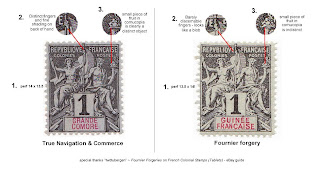Well, I had just begun collecting the 1892-1912 French Colonies "Navigation & Commerce" omnibus issue. I have a few and am definitely planning to get more...plus it's a topic I was researching anyway...so I blurted it out, and it stuck. Not 30 seconds later was I reflecting to myself "Dude, what have you just gotten yourself into?"
Hey this kid loves a challenge, right? So let's get to it:
OK, in the years prior to 1892 France was issuing postage stamps for use in her colonies abroad. They were not specific to the colony and are therefore referred to as "general issue" stamps. They looked something like this:
Notice, this stamp does not indicate what colony in which it should be used. Some smart cookies realized you could make a tidy profit by using these stamps to exploit variations in the rate of exchange in different colonies. Can't have that, can we?
So in 1892, just as the proverbial &*%$ was hitting the fan over the whole panama canal bankruptcy/bribery/corruption fiasco, important French people, taking a few moments to breathe between Jew hating sessions, issued the very first "territory-specific" omnibus stamps for it's colonies. These stamps featured allegorical representations of "Navigation" and "Commerce" and looked like this:
Notice, it was easy enough to print lots of these and then add the name of the specific
The idea went off like gangbusters and so, from 1892 to 1912, 28 French Colonies produced 491 different varieties of these babies, ranging from the humble 1 centime denomination to a full 5 francs! A significant source of this variation arose from the practice of overprinting surcharges on existing issues. Here's an example:
The stamp on the left is the original, while the one on the right bears a surcharge effectively changing the stamps value from "15" to "05". This was done in order to re-use surplus stamps and avoid unnecessary waste. It's the kind of thing you don't see much any more because we are now more forward-thinking, environmentally conscious people, and recycling is more important than ever if we want to save our pla ~ errr, ok, not a good example, moving on...
These stamps were so popular that intelligent and creative people decided to make their own! Yes, forgery is extremely common among these stamps, most notably those of a rather famous forger, Francois Fournier, and his little buddy Charles Hirshburger. These two were apparently so prolific that a random search through an average collection of "navigation and commerce" issues will likely turn up some well documented forgeries. But, how can you tell the real deal from a forgery?
Check this out:
There are three easy steps to identify a Fournier forgery among the navigation and commerce issues.
1) Checking perforations with a gauge - authentic "navcom" stamps are 14 x 13.5, while the forgeries are typically 13.5 x 14.
2) Checking Navigation's staff hand - it should have crisp discernable fingers, not just a blob with thin lines.
3) Checking the fruit in Commerce's cornucopia - it should appear as a distinct round shape set apart from the rim of the cornucopia. The rim of the cornucopia under the fruit is often either continuous or close to it on authentic stamps. On forgeries, the fruit shape is more oval in appearance and the rim is clearly compromised.
These details are plainly obvious under light at 10x magnification.
-- There's much more to learn about these stamps and I'm working on it...again there are 28 colonies and 491 unique issues...here's a quick peek at the spreadsheet I'm building to track my collection as I move forward:
And what you see there is really just the tip of the iceberg...when it's ready this "checklist" will go on for several pages in landscape format. Wish me luck and if you have interest in learning more about or collecting these let me know.

















